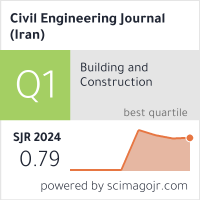Pedestrians' Speed Analysis for Two-Stage Crossing at a Signalized Intersection
Downloads
Pedestrian walking speed is an important and essential parameter for designing traffic signals at signalized intersections. However, there is a lack of understanding of pedestrian speed characteristics in a twice crossing. This paper focuses on analyzing the differences of pedestrians' crossing speeds between the two stages, and identifying the major factors affecting the speed changes. Pedestrians were classified by age, gender and group size, and pedestrians' speed characteristics of each group were analyzed. Besides, each age group were divided into five categories by gender and group size, and the effect sizes of gender and group size on speed-changing at the two stages were examined. The results show significant differences in walking speed on different gender and age groups, as well as on different group size. The young group has different factors affecting the speed change in the two directions, and the middle-aged and old groups have same factors affecting the speed change in the two directions. This study proposed a goal–oriented and time-driven behavior model for pedestrian two-stage crossing at signalized intersections, where the two directions have different pedestrian signal timing. The results also show that the proposed model is effective in simulating pedestrian speed characteristics of twice crossing. This research provides a theoretical basis for identifying pedestrian movement intention, optimizing signal timing, and improving pedestrian infrastructure at signalized intersections.
Downloads
[2] Yang, Xiaobao, Mohamed Abdel-Aty, Mei Huan, Yichuan Peng, and Ziyou Gao. "An Accelerated Failure Time Model for Investigating Pedestrian Crossing Behavior and Waiting Times at Signalized Intersections.” Accident Analysis & Prevention 82 (September 2015): 154–162. doi:10.1016/j.aap.2015.04.036.
[3] Jiang, Kang, Feiyang Ling, Zhongxiang Feng, Changxi Ma, Wesley Kumfer, Chen Shao, and Kun Wang. "Effects of Mobile Phone Distraction on Pedestrians' Crossing Behavior and Visual Attention Allocation at a Signalized Intersection: An Outdoor Experimental Study.” Accident Analysis & Prevention 115 (June 2018): 170–177. doi:10.1016/j.aap.2018.03.019.
[4] Yang R. The study of pedestrian delay based on setting method of pedestrian intersection. Southwest Jiaotong University. 2017.î—
[5] Li C. The study of traffic organization and examples on pedestrian twice crossing. Southwest Jiaotong University.2011.
[6] Wang X. Traffic Organization Methods and Applicability of Pedestrian Twice Crossing. Beijing Jiaotong University. 2008.
[7] Song, Chaoqun, Inhi Kim, and Qiaojun Xiang. "Evaluation of Large Signalized Intersection with New Pedestrians Twice Crossing.” Procedia Computer Science 109 (2017): 132–139. doi:10.1016/j.procs.2017.05.304.
[8] Li, Yue, and Geoff Fernie. "Pedestrian Behavior and Safety on a Two-Stage Crossing with a Center Refuge Island and the Effect of Winter Weather on Pedestrian Compliance Rate.” Accident Analysis & Prevention 42, no. 4 (July 2010): 1156–1163. doi:10.1016/j.aap.2010.01.004.
[9] Wang, Xuan, and Zong Tian. "Pedestrian Delay at Signalized Intersections with a Two-Stage Crossing Design.” Transportation Research Record: Journal of the Transportation Research Board 2173, no. 1 (January 2010): 133–138. doi:10.3141/2173-16.
[10] Ni Y, Cao Y, Li K. Pedestrians's safety perception at signalized intersections in shanghai. Transportation Research Procedia. 2017, 25: 1955-1963. doi:10.1016/j.trpro.2017.05.222.
[11] Zhang H., Wang Y., Ao G. Temporal and spatial characteristics analysis on pedestrian speed at signalized intersection. Journal of Guangxi University (Nat Sci Ed). 2016, 41(06):1879-1889.
[12] Zhang, Q, Yin C. The investigation and analysis of pedestrian crossing speeds at signalized intersections. Journal of Highway and Transportation Research and Development. 2010, 6(S1):121-122.
[13] Zhao Y. Qu Z. Jiang S. Hu H. Hu J. Pedestrian crossing speed characteristic based on video detection. Journal of Jilin University (Engineering and Technology Edition). 2013, 43(02):298-303.
[14] Wang Y. Analyzing on Pedestrian Crossing Behavior during Interval for Pedestrian Signal at Signalized Intersection. Chongqing Jiaotong University.2016.
[15] Duim, Etienne, Maria Lucia Lebrí£o, and José Leopoldo Ferreira Antunes. "Walking Speed of Older People and Pedestrian Crossing Time.” Journal of Transport & Health 5 (June 2017): 70–76. doi:10.1016/j.jth.2017.02.001.
[16] Muley, Deepti, Wael Alhajyaseen, Mohamed Kharbeche, and Mohammed Al-Salem. "Pedestrians' Speed Analysis at Signalized Crosswalks.” Procedia Computer Science 130 (2018): 567–574. doi:10.1016/j.procs.2018.04.102.
[17] Iryo-Asano, Miho, and Wael K.M. Alhajyaseen. "Modeling Pedestrian Crossing Speed Profiles Considering Speed Change Behavior for the Safety Assessment of Signalized Intersections.” Accident Analysis & Prevention 108 (November 2017): 332–342. doi:10.1016/j.aap.2017.08.028.
[18] Alhajyaseen, Wael K.M., and Miho Iryo-Asano. "Studying Critical Pedestrian Behavioral Changes for the Safety Assessment at Signalized Crosswalks.” Safety Science 91 (January 2017): 351–360. doi:10.1016/j.ssci.2016.09.002.
[19] Onelcin, Pelin, and Yalcin Alver. "The Crossing Speed and Safety Margin of Pedestrians at Signalized Intersections.” Transportation Research Procedia 22 (2017): 3–12. doi:10.1016/j.trpro.2017.03.002.
- Authors retain all copyrights. It is noticeable that authors will not be forced to sign any copyright transfer agreements.
- This work (including HTML and PDF Files) is licensed under a Creative Commons Attribution 4.0 International License.![]()















